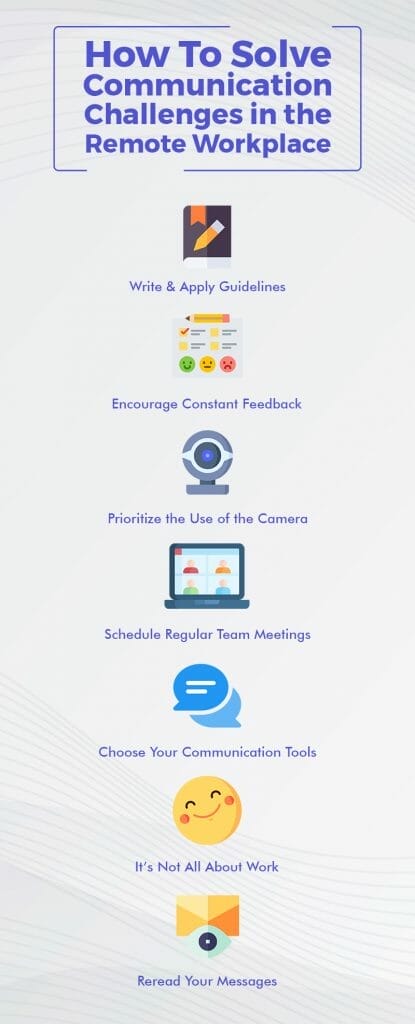Communication challenges can sometimes overshadow the many benefits of remote work, such as reduced commute stress, better work-life balance, cost savings, and increased productivity.
Since 2020, millions of people have transitioned fully into remote work; and it was the first time for many. According to research from IT service company Atlas Cloud, employees across all age demographics experienced a slight decline in communication quality as remote workers.
So, what are the typical scenarios where communication might falter in a remote work setting
5 Ways Communication Can Go Wrong When You’re Working Remotely
1. Misinterpretation of Tone and Intention
One of the biggest challenges of remote work is the absence of non-verbal cues, such as facial expressions, body posture, gestures, and tone of voice. Without these cues, it’s easy for us to fill in the blanks of what the other person sending the email or chat message intended. This can lead to misunderstandings and, as a result, poor business decisions.
Solution: To avoid misinterpretations of your written messages, always strive for clarity in your language. Be explicit, provide context, and add the occasional emoji to convey your tone when appropriate. When in doubt, opt for video calls where facial expressions and gestures can help fill in the blanks.
2. Lack of Face-to-Face Interaction
Remember those water cooler chats or impromptu brainstorming sessions? Unfortunately – or fortunately, depending on your circumstances – remote work will have you missing out on those. While some people may actually prefer not having to talk to their colleagues face-to-face, the fact is that remote work can sometimes feel isolating, even for absolute introverts. This can make employees feel alone and disconnected from their team members.
Solution: Scheduling regular virtual meetings and quick video huddles can greatly improve remote communication. This is the ideal time for team members to discuss ideas, ask questions, and share updates.
3. Different Time Zones
You’re bright-eyed and ready to tackle a project, but your colleague from a different part of the world is sleeping and won’t be available for another eight hours. Collaborating across different time zones can make work and communication challenging, but thankfully not impossible.
Solution: Set clear expectations for response times and availability across time zones. Use scheduling tools to find those golden overlapping hours for meetings that accommodate everyone’s schedules. You may also want to use a shared calendar that displays different time zones to facilitate coordination.
4. Chaotic Virtual Meetings
Video calls are great, but they still lack some of the visual cues present in face-to-face interactions. This can cause participants to inadvertently talk over each other, which can lead to confusion.
Solution: Practice good video conferencing etiquette by muting your microphone when not talking and using hand gestures to signal your intention to speak. Don’t forget to use a virtual background to create a positive image and minimize distractions!
5.No Sense of Belonging
Remote work can sometimes feel like you’re on a solitary island. Without the physical presence of coworkers, it can be challenging to foster a sense of belonging and camaraderie within a team.
Solution: Organize virtual team-building activities, casual video chats, and online social events to create a sense of community. It’s always a good idea to start meetings with a brief personal check-in to encourage team members to share updates about their lives beyond work.
Hot to Solve Communication Challenges in the Remote Workplace
Remote work is beneficial but can make communication tricky. Let’s explore simple, effective solutions to these challenges, making work easier and more productive for everyone.

Write and Apply Guidelines
One of the most critical concerns among remote workers is that they lack evidence of their colleagues’ work. When you’re at the office, it’s easy to see who is productive and who pretends to be. Working from home, you lose sight of what other employees do.
Setting guidelines and protocols for delivery will help keep everyone aligned. There’s no way to prove your colleagues are online when their green light is on. But if they complete their tasks on time, you’ll know they are productive.
So you could use the same communication tool – such as Basecamp – with the whole team to avoid distractions and stay updated on shared tasks. Try to share your work hour routine and availability at specific times to keep them aligned on your working hours. Also, remember to answer messages as fast as possible to prioritize effective collaboration and time management.
Encourage Constant Feedback
Feedback is a fantastic way to increase motivation. Both positive and negative criticism can transform and significantly evolve your remote team. As Bill Gates once said, “We all need people who will give us feedback; that’s how we improve.” And it’s entirely true!
Whether from a colleague or a supervisor, everyone needs to feel valued and accepted. Unfortunately, this can be difficult when you don’t have a personal relationship with your coworkers. That’s why feedback is so important in remote teams. Encouraging constant feedback from your colleagues could help you progress on projects and get to know each other better.
Feedback is essential for growth, honing skills, and boosting self-assurance, and it can be administered in numerous ways. Arranging weekly virtual meetings can ensure continuous feedback within the team. This regular interaction not only promotes engagement, and trust but also fuels motivation, sparking the creation of innovative projects
Prioritize the Use of the Camera
Working from home eliminates all visual contact. It’s not like being in an office. During the whole day, you’ll wear the clothes you want, sit wherever you find comfortable, and listen to the music your mood is up to – even if it’s rock and roll – until you have a team meeting.
Though one of the reasons you love working from home is to do it in your pajamas, your coworkers need to see you. According to a study by Psychology Today, nonverbal cues make up over 93% of communication, so relying on messaging platforms and emails isn’t enough.
Video conferencing allows employees to develop stronger relationships with others on the team. It also stimulates team bonding since the talk isn’t always about work projects. But it’s only possible if you allow them to see you. So turn that camera on!
Schedule Regular Team Meetings
Poor communication reduces productivity among remote teams. When employees don’t meet regularly, work gets progressively siloed. And since they are working from home, more extended periods of loneliness and lack of communication can make them feel out of the loop.
Regular meetings prevent team members from feeling isolated. Together with your team, you could schedule a once-a-week video meeting for updates and progress reports on the projects each of you worked on. Regular virtual meetings strengthen teamwork and increase collaboration among remote team members.
But remember to strike the right balance between virtual meetings and schedules. It’s easy to fall into overdoing it with discussions, and suddenly your whole day is crowded with calls. Too many are a waste of time. Set a schedule for team meetings once a week and save some free time in case you need a 1:1 with a colleague.
You may want to read: How to Deal with Toxic Remote CoWorkers
Choose Your Communication Tools
It’s no news that productivity and satisfaction among remote workers have grown since the COVID-19 pandemic. Millions of worldwide companies adopted new practices and worked every day to help employees increase their effectiveness at work. However, productivity directly depends on choosing and implementing the right tools for remote workers.
The purpose behind communication tools is to keep everyone aligned and engaged with projects. This helps avoid miscommunication that can pop up during your workday since you can review valuable information. There are thousands of communication tools you could adopt for your team. Most only take a few minutes to download and set up.
Together with your team, you could select a couple of tools for use at different times. You could use Zoom for video conferencing with your team, Slack for regular messaging, and Basecamp to keep track of all projects. Try to choose the one that’s more accessible and culturally connected for you and your colleagues.
It’s not all about work
Can you remember how awkward you felt during your first virtual meeting? People are talking to each other about shared projects, laughing about jokes you didn’t understand. You felt entirely out of the loop. How can you avoid that kind of meeting?
Working remotely keeps you away from the casual chat between colleagues that might have happened at the office. You went out for lunch with them, shared some 5-minute coffee, or even ran into each other at the office corridors. But working from home doesn’t mean everything you share with your team has to be about work.
Make some time for friendly chats with your coworkers. Try to get to know them better, get more personal with them. Do they have a pet? Do they live alone? What are their interests? You could also schedule a weekly time to play a game and help everyone relax. Bonding with your remote team could help you even improve your results at work.
Reread Your Messages
Written messages can often cause misunderstandings. The tone, the intention, or the expression may differ from the one you interpreted, and a snowball of miscommunication begins.
Though team messaging and emails can be excellent for urgent and casual communication, you must know how to express yourself through them. Make sure you reread your messages before sending them off to reduce the chance of wrong interpretations. It’ll only take you a few minutes, and you’ll save yourself from many misunderstandings.
Learn to Defuse Tense or Angry Situations
It happens to the best of teams: tempers flaring, fingers typing furiously, frustration palpable through the screen. In these moments, having certain nonviolent communication strategies in place becomes critical.
First, it’s important to take a step back and breathe – emotions can cloud communication so you want to give yourself time to cool off before dealing with the situation.
Then, choose the right channel for your conversation – public for praise, private for constructive criticism. Sometimes, a one-on-one chat is all it takes to bridge the gap. During your conversation, practice active listening – tune in to understand the other person, not just to respond. Acknowledge the other party’s perspective to build empathy and rapport, and shift the focus from blame to personal feelings. Say, “I felt confused when you…” to allow for a more constructive conversation.
If you find a message unclear or even hostile, seek clarification before assuming the worst. A simple, “Can you elaborate?” can often clear up misunderstandings. Remember, it’s okay to agree to disagree respectfully. Not every discussion needs a winner. When it comes to workplace communication, whether remote or not, it’s best to focus on finding common ground.
Finally, after a tense conversation, it’s a good idea to follow up with a summary of the discussion and agreed-upon action items. This will ensure that both you and your coworker are on the same page and are committed to moving forward positively.
Ready to Make the Change?
While remote offers numerous benefits to both employees and employers, it also comes with its fair share of challenges, specifically communication challenges. By recognizing potential communication pitfalls and embracing the strategies outlined in this blog, you can enhance remote communication, strengthen teamwork, and defuse tense situations when necessary.
You can make your switch now. You know the challenges, you have faced them, and they’ve been demanding. But the difference is you now know how to solve them. Get to know your colleagues, try to connect with them if you assign them a task, and detail it as much as you can. In a remote workplace, it´s better to say more than to lack information. And remember, clear, thoughtful, and regular communication is the cornerstone of any successful remote work experience.!






